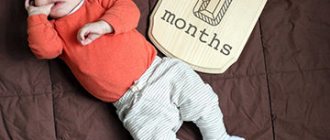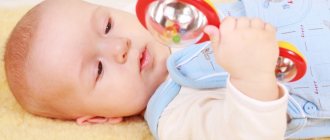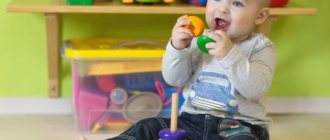The first month of a baby’s life is the most exciting for both him and his parents, because he finally took his first breath and saw his mom and dad. Now he and his parents have a lot more interesting things to do! Before the baby turns one month old, he is considered a newborn, and all his talents come down to unconditioned reflexes and prolonged sleep. But many mothers are concerned with the question of how, during this short period, they can contribute to the development of the baby and make sure that he is in good health? In this article you will find the answer and a lot of useful information.
Games
Since a newborn cannot concentrate for long and gets tired quickly, games and exercises should be simple and last only a couple of minutes. Nursery rhymes will help in the development of a child. They can accompany active games, for example, spreading the baby’s arms to the sides, then crossing them on the chest, and then gently lifting them up, saying:
“We woke up, we woke up, We stretched sweetly, We smiled at Mom and Dad.”
Instead of stretching, there can be any other movements - stroking arms and legs, light massage of the feet and palms. It is also useful to play “hide and seek” with your child - cover his face with a diaper and immediately take it off, saying: “Peek-a-boo! Where are you?".
The right time for such fun is the moment of changing clothes and active wakefulness. It is important that the baby is not hungry and feels good. It is advisable that not only mom but also dad play with him. The parents' different approaches to business will be interesting to the baby and will help him get closer to his father.
Activities for speech and hearing development
Equally important are activities with a 1-month-old child aimed at developing speech and hearing. Of course, it is still too early to learn speech as such, but now you can begin to develop speech hearing. To do this, you need to talk more with the child, teaching him to recognize intonations, for example, comment on everything that is happening around him, sing songs, recite rhymes.
In addition, in the first month of a baby’s life, onomatopoeia can be taught. Start with the simplest thing - repeat individual vowel sounds (a-a-a-a, u-u-u-u, i-i-i-i) so that the newborn can see your face. Over time, he will begin to repeat them after you - this is one of the first stages in the formation of speech.
For additional hearing stimulation, children are recommended to include classical music, sounds of nature, and funny songs. Of course, don't forget about rattles. To develop hearing and at the same time be aware of your movements, you can tie a small bell to the child’s arm or leg. This will make it easier for him to gain control over his body.
You can also help your baby learn to identify which direction the sound is coming from. Just play with him, ringing the rattle from one side to the other of the child. Other toys for hearing development are also suitable - soft squeakers, a mobile for the crib, and the like.
Social and psychological development
From the first days of life, babies intuitively sense the emotional state of an adult. They adapt to it; it determines the child’s idea of the world.
A tired and nervous mother signals to her child that the world is dangerous. Smiling and calm gives a feeling of security.
Indicators of normal socio-psychological development of an infant per month include:
- crying as a way to ask for help;
- remembering objects shown repeatedly within a few seconds;
- the child calms down and becomes quiet when one of the parents takes him in his arms;
- ability to make eye contact with mom or dad;
- The baby reacts to the voice of a familiar adult.
Babies are able to adapt their body position to the person holding them. They are able to fix their gaze on the smiling face of mom or dad.
Activities for vision development
It is known that a newborn is not yet able to focus his vision on objects. By getting your baby interested in bright or contrasting colored toys, you will help him learn to recognize colors and things.
The simplest way is to show the child a rattle, holding it up so that he can see it clearly (the distance to the eyes is no more than 35 cm). Then, slowly move the toy left and right, up and down, and also in a circle.
You can automate the process of vision development in your baby by hanging rattles in the crib. Another thing that helps to focus your vision is a mobile phone. Such devices are produced to suit every taste - with bright figures, music, lighting.
Activities to develop motor skills
Classes with a 1-month-old baby must include exercises to develop motor skills and touch. Games such as “Magpie-Crow”, “Ladushki” and other movements associated with the stimulation of tactile sensations will help with this.
To develop a child’s cognitive activity, massage his fingers and toes, let’s touch objects with different textures - smooth, rough, embossed, fluffy. You can tickle your baby's palms and feet with a soft brush or feather.
Although your newborn may not yet be able to hold objects in his hands, you can place light rattles in his hands. An exercise with rings would also be a good workout.
To do this, take two plastic rings of a suitable size (you can use rattles or teethers), preferably with a grooved surface, and place them in the baby’s palms. After making sure that he squeezed them tightly, grab the rings on the other side and try to move them so that the baby’s arms rise and fall. The lesson will be more fun if you tell him nursery rhymes in time with his movements.
How to entertain and develop your baby
For babies in the first three months of life, rattles with different fillings are suitable. They can be made of plastic, wood or fabric. The more varied the textures that your baby’s fingers come into contact with, the better. The development of tactile sensations stimulates the development of speech.
A bright rattle can be used to stimulate the visual system. Hold it near the baby's face at a distance of about 40 centimeters. When he focuses his gaze on her, smoothly move her, then to the right, then to the left.
Hanging musical mobiles can be used to develop hearing. You can stimulate both hearing and speech by reading simple nursery rhymes to your baby, including nursery rhymes.
Physical development
Gymnastics for a 1 month old baby is necessary for his physical development and well-being. It includes simple exercises - carefully bending the arms and legs, lifting the baby by the arms, after placing your fingers in his palms so that he can hold himself.
Already at this age, a child can be taught to hold his head. To acquire this skill, it is recommended to periodically lay it on your stomach. The time for such an exercise should be limited. As soon as you see that the child is tired, turn him over to his usual position.
Gentle stroking of the back, arms and legs is also useful. To prevent your baby from suffering from colic, it is recommended to lightly massage his tummy in a clockwise circular motion.
It is better to perform exercises and massage 30 minutes before feeding, on a full stomach and before bedtime, physical impact is undesirable. The optimal duration of classes is 2-4 minutes.
Caring for a newborn in the first month of life
An important part of caring for a newborn in the first month of life is feeding. Most pediatricians recommend establishing breastfeeding on demand. And for children on IV, it is more advisable to adhere to the “hourly” strategy.
The baby digests breast milk faster, so the intervals between feedings during the first weeks of life can be 2-3 hours. Then they will increase to 4 hours.
Hygiene
Every morning you need to wash your baby and, if necessary, clean his nose. To do this, use boiled water and cotton pads. The nasal passages are cleaned with special cotton swabs with limiters.
After each diaper change, the child is washed under running warm water or the perineum is wiped with wet wipes. If you neglect this, there is a high risk of developing diaper rash or dermatitis.
Bath the baby until the umbilical wound heals only in boiled water. A weak solution of potassium permanganate is added to it. If desired, you can take baths with infusions of calendula and chamomile. They will calm the nervous system and help you fall asleep faster.
The umbilical wound is treated with hydrogen peroxide in the morning and after bathing. Carefully remove the crusts using a cotton swab.
Fitball exercises
Another type of permitted physical activity is exercise on a fitball; for a 1-month-old baby, they will become both training and entertainment. Fitball is a large gymnastic ball used to strengthen various muscle groups, as well as the spine.
Why is exercise on a fitball necessary for a newborn? Firstly, it improves the functioning of the vestibular apparatus in the child. Secondly, swinging on a ball on your tummy contributes to the normal functioning of the gastrointestinal tract and helps get rid of gases.
In addition, such exercises reduce muscle hypertonicity, which is often found in newborns. Exercises on a fitball are not only useful, but also pleasant - smooth rocking reminds the baby of the time when he was in his mother’s tummy.
Rules and precautions
You should not start classes immediately after being discharged from the hospital. You need to wait for the umbilical wound to heal, give the child time to adapt at home, and establish a sleep-wake schedule.
It is important that the fitball is suitable for exercising with a newborn. The optimal ball is 75 cm in diameter, quite dense, with a nipple soldered inside and without noticeable seams. It must withstand a weight of up to 150 kg, this is the key to strength and the fact that in the future all family members will be able to use the fitball.
You should start doing exercises half an hour before feeding or an hour after it. Fitball exercises for 1-month-old infants begin with 3-5 minutes a day, gradually increasing the duration.
It is better to do exercises accompanied by calm classical music. It’s good if you can do them in front of a mirror; children love to watch their reflection.
For hygiene purposes, the ball is covered with a diaper, and the baby is placed on the stomach on top in the center. At this time, mom is sitting on the sofa or chair, the fitball is in front of her. To avoid injuring your child, avoid applying force to his hands and feet. The newborn's joints are not yet strong enough for this.
Set of exercises
For the first time, a few exercises are enough for the baby. For children aged 2 weeks to 6 months, the following complex is recommended:
- Exercise No. 1. We place the child on his tummy in the center of the fitball so that his chest, head and hips are adjacent to the ball. Then we place our palm on his back for fixation and gently rock the fitball back and forth, left and right, and also in a circle. This promotes the passage of gases and trains the baby’s vestibular apparatus.
- Exercise No. 2. Turn the baby over and place him on the exercise ball on his back. Holding his chest and tummy, swing him on the ball from side to side. Exercise helps strengthen the back muscles and maintains the spine in the correct position.
- Exercise No. 3. Place the baby on the fitball with his tummy down and, holding him by the legs, very gently press on his back and butt to create springy up and down movements. The same can be done by turning the child on his back.
- Exercise No. 4. The baby is placed on his back on a sofa or bed so that his legs protrude slightly over the edge. Then, they roll the fitball to his legs and he instinctively pushes the ball away. The exercise is accompanied by funny songs or rhymes.
By devoting time every day to your child’s physical development, you will strengthen his health and speed up the acquisition of his first skills. Even if not immediately, the results from the classes will definitely appear. The main thing is to perform the exercises when the baby is feeling well and stop them as soon as he shows signs of fatigue.
Sleep Features
The first month of a newborn’s life passes in constantly alternating phases of sleep and wakefulness. During the first weeks, the baby sleeps about 20 hours a day, waking up to eat and briefly explore the world around him.
A baby is characterized by so-called REM sleep. Therefore, babies often wake up from any extraneous sound or attempt to transfer them from their hands to the bed. The child has not yet developed circadian cycles; he has no idea of day and night.
During this period, it is important to establish a sleep and wakefulness routine. If your child wakes up in the middle of the night and does not fall asleep, do not turn on the light, play with him or talk to him. It is better to place the baby next to you or rock it in your arms.
By the end of the fourth week, the average daily sleep time is reduced to 16-17 hours.











